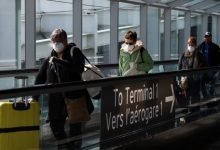Canadian Forces calls back ships, cuts missions short due to COVID-19
The Canadian military is taking what it calls “unprecedented measures” to protect its members from COVID-19 and prevent the spread of coronavirus, all while making sure it can still conduct essential operations.
To do that, it has cut missions short, recalled ships, sequestered sailors in a hotel and put in a range of self-isolation rules.
The worldwide spread of COVID-19 is impacting operations across all regions, Andrée-Anne Poulin, a spokesperson for the Department of National Defence, said in an email.
“We will do everything we can to ensure our sailors return home as safely as possible,” she said.
DND has more than 2,000 personnel deployed on approximately 20 missions, many of which have had to alter their activities in response to the pandemic.
Four navy ships with a total of about 160 people on board had to scrap the remainder of their international missions and head home from Africa, the Caribbean and the eastern Pacific.

The sailors aboard HMCS Glace Bay and HMCS Shawinigan are returning from Africa after two international military exercises were cancelled. Those ships will arrive in Halifax by mid-April.
Meanwhile, the crews of HMCS Nanaimo and HMCS Whitehorse are on their way home from the Caribbean basin and eastern Pacific Ocean, where they were helping American forces stop trafficking by organized crime. They weren’t originally supposed to be back in Canadian waters until mid-May, but will now drop anchor off the B.C. coast in early April.
But it’s unclear if the sailors will stay aboard their ships in case they’re needed, or whether they will return home and self-isolate for 14 days.
“Our chain of command is discussing the different options for the crews’ return to Canada and consulting with our health-care team on what is best for our sailors and their families,” Poulin said.
Why ships aren’t great for physical distancing
The tight quarters aboard ship make navy crews especially vulnerable to COVID-19 because it’s very difficult to stay two metres away from others.
“Modern warships are not designed to permit ideal social distancing. Navy leadership and individual command teams are using common sense to create physical distance onboard ships to the greatest extent possible,” said Poulin.

To keep the virus off vessels, personnel are being screened prior to sailing. Sailors are checked for symptoms of COVID-19, their recent travel history is examined and they’re scrutinized to see if they have had any potential contact with someone who had the coronavirus.
Some navy crews have even been sequestered in a Halifax hotel to help prevent exposure to COVID-19 before they sail.
How experience is helping
Poulin said the military has a lot of experience successfully managing infectious diseases on bases, camps and on ships.
In the past six months of deployments, Canadian Armed Forces Health Services workers have managed some cases of influenza and gastroenteritis, and the same techniques are being applied to the coronavirus.
Staff have been educated about the virus, all units are encouraging their teams to practise a high level of personal cleanliness and a ship cleaning routine is followed twice a day focusing on high-touch surfaces such as handles and handrails.

Task forces that have been deployed are also not participating in training activities, exercises, events or public gatherings that will put personnel at risk or contribute to the spread of COVID-19.
At home, only skeleton crews are at work at military bases because the majority of Canadian Armed Forces personnel has been ordered to work from home. Civilian employees are expected to do the same. Only DND staff who are physically required to conduct critical tasks are allowed on DND property.
As of Nov. 30, 2018, there were 67,453 regular forces personnel, according to a 2019-20 departmental plan.
DND would not say how many people across the country are working from home and how many are still working on site.
CBC








Redes Sociais - Comentários